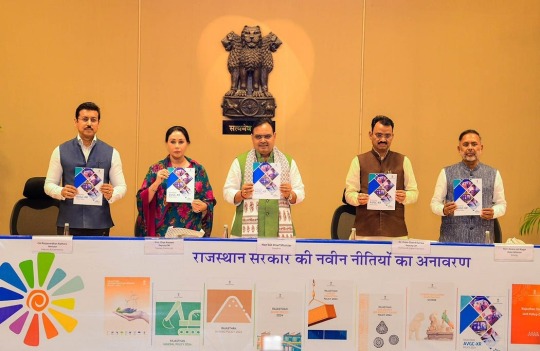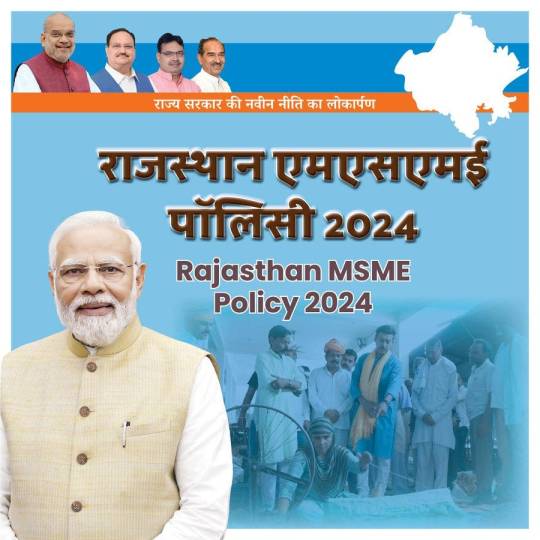#msme schemes for business
Explore tagged Tumblr posts
Text
To get complete knowledge on Startup India Seed Fund Scheme, join a course at https://www.msmekipathshala.com/course/SEEDFUNDING-47561
0 notes
Text
Union Budget 2024 Is A Blueprint for Inclusive Growth: Bharat Vasani
Former SCCI official lauds focus on rural development and MSMEs Finance Minister’s proposals aim to boost eastern states and formalize labor market. JAMSHEDPUR – Local business leaders, including, Bharat Vasani, have generally lauded the union budged and have offered insights on the latest fiscal roadmap for India. The Union Budget 2024 has received a positive assessment from Bharat Vasani, a…
#बिजनेस#business#E Shram portal#Eastern India Development#Indian economic growth strategy#Jamshedpur business perspective#labor market formalization#MSME support measures#PURVODAYA scheme#rural development initiatives#SCCI budget response#Union Budget 2024 analysis
0 notes
Text
Navigating The MSME Loan Government Scheme: A Comprehensive Guide
Micro, Small, and Medium Enterprises (MSMEs) play a crucial role in the economic growth and development of countries around the world. In recognition of their importance, governments have introduced various schemes to support these enterprises, including the MSME loan government scheme. This comprehensive guide aims to help business owners understand the intricacies of this scheme, including eligibility criteria, application processes, and available subsidies.
Understanding the MSME Loan Government Scheme
The MSME loan government scheme is designed to provide financial support to small and medium enterprises. This support comes in various forms, including loans, grants, and subsidies for MSMEs. These initiatives help businesses overcome financial hurdles, expand operations, and achieve sustainable growth.
Key components of the MSME loan government scheme
1. MSME business loan eligibility
To qualify for an MSME loan, businesses must meet specific criteria. These include the size of the business, annual turnover, and the nature of the enterprise. Understanding the MSME business loan eligibility criteria is essential for applicants to ensure their application stands a good chance of approval. Typically, businesses must be registered under the MSME category and adhere to the defined limits for investment in plant and machinery or equipment.
2. Unsecured business loan for MSME
One of the significant advantages of the MSME loan government scheme is the provision for unsecured business loans. Unlike traditional loans that require collateral, unsecured business loans for MSMEs provide access to capital without the need to pledge assets. This is particularly beneficial for small businesses that may not have significant assets to offer as collateral.
3. MSME subsidies and grants
The government offers various subsidies and grants to MSMEs to reduce the financial burden and encourage business growth. These MSME subsidies can cover aspects such as technology upgrades, quality improvement, and market development. Applying for an MSME grant can provide businesses with the necessary funds to innovate and compete in the market.
4. Govt scheme for small scale industry
There are numerous government schemes tailored specifically for small scale industries. These schemes provide a mix of financial support, training, and advisory services to help small businesses thrive. By taking advantage of a govt scheme for small scale industry, business owners can access resources that might otherwise be out of reach.
5. MSME loan process
The MSME loan process involves several steps, from application to approval. Business owners need to prepare detailed documentation, including business plans, financial statements, and proof of business registration. Understanding the MSME loan process helps ensure that applications are complete and submitted correctly, increasing the likelihood of approval.
6. MSME guidelines for payment
MSME guidelines for payment are designed to ensure timely and fair transactions within the sector. These guidelines protect small businesses from delayed payments and ensure they have a steady cash flow to support operations. Adhering to these guidelines is crucial for maintaining financial health and building trust with partners and suppliers.
How to apply for an MSME loan government scheme
1. Prepare necessary documentation: Gather all required documents, such as business registration certificates, financial statements, and business plans. This preparation is essential for a smooth application process.
2. Choose the right scheme: Identify the most suitable MSME loan government scheme based on your business needs. Whether it's an unsecured business loan for MSME or a specific grant, choosing the right scheme can significantly impact your business's success.
3. Submit the application: Fill out the application form accurately and submit it along with the required documents. Ensure that all information is correct and complete to avoid delays.
4. Follow up: After submission, regularly follow up on the application status. This proactive approach can help address any issues promptly and keep the process moving.
Benefits of the MSME loan government scheme
1. Financial support: Access to necessary funds without the need for significant collateral, thanks to unsecured business loans for MSMEs.
2. Growth opportunities: Subsidies for MSMEs and grants enable businesses to invest in growth opportunities, such as technology upgrades and market expansion.
3. Enhanced competitiveness: Government schemes help small businesses improve their products and services, making them more competitive in the market.
4. Improved cash flow: MSME guidelines for payment ensure timely transactions, helping businesses maintain a healthy cash flow.
Conclusion
Navigating the MSME loan government scheme requires a thorough understanding of the eligibility criteria, application process, and available benefits. One noteworthy example is Klub, a platform that focuses on revenue-based financing, providing startups with growth capital without requiring equity.By leveraging these schemes, small and medium enterprises can access essential financial support, drive growth, and contribute significantly to the economy. Whether seeking an unsecured business loan for MSME or applying for an MSME grant, these government initiatives provide invaluable resources for business success.
#msme guidelines for payment#msme business loan eligibility#govt scheme for small scale industry#msme subsidies#subsidies for msme#msme loan process
0 notes
Text
MSME Loan Schemes: Apply Now for Financial Support
Secure financing with specialized MSME loan schemes. Empower your business with accessible funds and favourable terms.

0 notes
Text
Micro-Business Empowerment: Unveiling 5 Key Insights into CGTMSE Loan Schemes for Sustainable Growth
Micro-Business Empowerment: Unveiling the Pros and Cons of CGTMSE Loan Schemes for Sustainable Growth: Key Insights into CGTMSE Loan Schemes for Sustainable Growth India’s vast network of Micro, Small, and Medium Enterprises (MSMEs) forms the backbone of the nation’s economy. However, securing funding for these small businesses often proves challenging due to their perceived higher risk profile.…

View On WordPress
#Business Development#CGTMSE Loans#CMA Data#Credit Guarantee Fund Scheme#Empowerment#Entrepreneurship#Financial Consulting#Financial Empowerment#Loan Schemes#Micro-business#MSMEs#Project Reports#Pros and Cons#Small Business Financing#Sustainable Growth
0 notes
Text
Lending money to small and microbusinesses without requiring collateral is the goal of CGTMSE. Gaining knowledge of the fundamental requirements for CGTMSE loans can improve your chances of getting authorized. Verify your eligibility right now.
0 notes
Text
How to Get a Business Loan without Collateral
Understanding Collateral and Non-Collateral Loans
Collateral refers to an asset or property that a borrower pledges to a lender as a form of security in exchange for obtaining a loan. It serves as a safeguard for the lender, providing assurance that if the borrower fails to repay the loan, the lender can take ownership of the collateral to recover the owed amount. In traditional loan processes, collateral plays a significant role in reducing the lender's risk and increasing the likelihood of loan approval. Collateral acts as a safety net for lenders, reducing the potential loss in case a borrower defaults on the loan. By having a valuable asset to claim, lenders can recover at least a portion of the outstanding debt. Lenders may offer lower interest rates on loans secured by collateral. This is because the presence of collateral provides lenders with a sense of security, allowing them to extend more favorable terms to borrowers. Collateral allows borrowers to access larger loan amounts than they might qualify for with an unsecured loan. The value of the collateral can determine the upper limit of the loan.

Collateral-based loans come with inherent risks that borrowers should carefully consider before committing to such financing arrangements. When a borrower pledges an asset as collateral, they expose themselves to the possibility of losing that asset in case of loan default. For instance, if a business owner uses their property as collateral for a loan and subsequently faces financial difficulties leading to default, the lender could seize the property, resulting in significant personal and financial setbacks. Moreover, the value of the collateral can depreciate over time or in unfavorable economic conditions, potentially leaving borrowers owing more than the collateral's worth. This "underwater" scenario can lead to financial distress and even bankruptcy. Collateral-based loans can also restrict borrowers' financial flexibility, as they might need to seek lender approval for certain business decisions or asset transactions, limiting their autonomy. On the other hand, non-collateral loans offer a distinct advantage by eliminating the need for pledging assets, thus mitigating the risks associated with collateral-based borrowing. These loans are often based on a borrower's creditworthiness, business revenue, and repayment capacity, rather than relying on tangible assets. This approach grants borrower's greater peace of mind, as their personal or business assets remain safeguarded. Non-collateral loans provide an accessible avenue for startups and small businesses that may not possess substantial assets for collateral. Additionally, the application process for non-collateral loans can be streamlined and less time-consuming, allowing borrowers to secure funds more quickly. This type of financing also fosters greater financial flexibility, enabling borrowers to allocate funds as needed without constraints imposed by collateral-related terms.
Types of Business Loans without Collateral
Non-collateral business loans encompass a range of financing options that do not require borrowers to pledge assets as security. Unsecured loans, one such option, provide funds based on the borrower's creditworthiness and financial history. These loans often have higher interest rates to compensate for the absence of collateral. Working capital loans offer short-term financial support to cover day-to-day operational expenses, ensuring smooth business operations. Invoice financing, another non-collateral choice, enables businesses to borrow against outstanding invoices, improving cash flow while awaiting payment from clients. These non-collateral loan options empower businesses by providing essential funds without risking valuable assets. Real-world success stories exemplify the effectiveness of non-collateral loans. For instance, a tech startup secured an unsecured loan to expand its software development operations. Despite lacking substantial collateral, the startup's promising business model and strong credit profile convinced the lender to extend the necessary funds. Similarly, a local manufacturing company obtained a working capital loan to manage seasonal fluctuations in demand and maintain inventory levels. This injection of funds enabled the company to seize growth opportunities and enhance its market presence. Additionally, a creative agency utilized invoice financing to bridge cash flow gaps caused by extended client payment cycles. By leveraging their outstanding invoices, the agency accessed immediate funds, ensuring timely project execution and client satisfaction. These real-life examples underscore how non-collateral loans can catalyze business growth and success.
Tips to Enhance Loan Eligibility.
Enhancing loan eligibility involves taking proactive steps to present a favorable financial profile to potential lenders. Here are some valuable tips to improve your chances of qualifying for a business loan:
Build and Maintain a Strong Credit History : A healthy credit score significantly impacts loan eligibility. Pay bills and debts on time, reduce credit utilization, and rectify any errors in your credit report.
Strengthen Financial Statements : Maintain accurate and up-to-date financial records, including income statements, balance sheets, and cash flow statements. Lenders evaluate these documents to assess your financial health.
Craft a Comprehensive Business Plan : A well-structured business plan illustrates your goals, strategies, and market understanding. It reassures lenders that you have a clear vision for your business's success.
Reduce Debt-to-Income Ratio : Lowering your debt-to-income ratio by paying off existing debts can improve your debt repayment capacity and enhance your attractiveness to lenders.
Showcase Collateral (if available) : Even in non-collateral loans, collateral can enhance your application. If you have valuable assets, their presence can positively influence your loan eligibility and terms.
Remember that each lender may have slightly different eligibility criteria, so research and tailor your application accordingly. Following these tips can significantly enhance your chances of securing the business loan you need.
Building a Strong Business Case
Creating a persuasive business case that showcases the viability of a loan investment requires a meticulous approach. Start by outlining your business's goals, detailing how the loan will be utilized to achieve them. Provide a comprehensive overview of your industry, highlighting market trends, competition, and potential growth opportunities. Clearly articulate the problem your business aims to solve and how the loan will directly contribute to that solution. Back your case with tangible data, such as financial projections, ROI estimates, and a breakdown of how the loan will positively impact revenue, profits, and operational efficiency. Present a well-researched risk assessment, acknowledging potential challenges and outlining strategies to mitigate them. A compelling narrative that combines solid data, strategic planning, and a clear path to success will make your business case resonate with lenders and instill confidence in your loan proposal. A well-thought-out business plan and accurate financial projections form the backbone of any successful loan application. A robust business plan demonstrates your deep understanding of your industry, target market, and competitive landscape. It outlines your business's unique value proposition, strategies for growth, and potential challenges. Financial projections, including revenue forecasts, expense estimates, and break-even analysis, offer a glimpse into your business's financial future, showcasing its sustainability and potential profitability. Lenders rely on these projections to assess your ability to repay the loan and manage financial obligations. A solid business plan and precise financial projections not only inspire lender confidence but also serve as a roadmap for your own business endeavors, ensuring that you're well-prepared to navigate challenges and capitalize on opportunities.
Managing Finances and Repayment
To ensure optimal utilization of the loan funds for driving business growth, strategic financial management is essential. Begin by outlining a detailed budget that allocates funds to key areas such as marketing campaigns, inventory expansion, technology upgrades, and hiring skilled personnel. Regularly monitor and track expenses against the budget to maintain fiscal discipline. Prioritize investments that directly align with your business goals, maximizing the return on investment and fostering sustainable expansion. Additionally, consider setting aside a portion of the funds as a contingency reserve to address unforeseen challenges. Consistent financial analysis and prudent decision-making will enable you to harness the loan funds effectively, accelerating your business's trajectory toward success and prosperity.
Tips for maintaining a positive cash flow and utilizing the funds strategically
Maintaining a positive cash flow and strategically utilizing funds are critical for sustainable business growth. Here are some tips to achieve these goals:
Accelerate Receivables : Encourage timely payments from customers through incentives or penalties for late payments. This accelerates cash inflows and enhances liquidity.
Prioritize High-Value Investments : Allocate funds to initiatives that directly contribute to revenue generation or cost savings. Strategic investments ensure maximum returns on the funds utilized.
Build Emergency Fund : Set aside a portion of your cash reserves as an emergency fund to cover unexpected expenses, reducing the strain on your working capital.
Diversify Revenue Streams : Relying on a single revenue source can be risky. Diversify your offerings or target markets to create stable, multiple income streams.
Optimize Inventory Management : Keep inventory levels lean by using data-driven inventory management techniques. This prevents tying up excess capital in unsold goods.
Review and Adjust : Regularly review your financial strategies and adjust as needed based on changing market conditions, business performance, and cash flow patterns.
Conclusion
In the dynamic landscape of business financing, the realm of non-collateral loans presents a realm of possibilities for growth-oriented ventures like Mpower Credcure. These financing avenues unlock opportunities that transcend traditional constraints, enabling businesses to access vital capital without jeopardizing valuable assets. By embracing non-collateral loan options, Mpower Credcure and fellow entrepreneurs can tap into a new era of financial flexibility and empowerment. It's imperative to recognize that these opportunities exist to fuel innovation, enhance operational capabilities, and foster expansion, serving as a catalyst for achieving ambitious goals. As we navigate the ever-evolving business landscape, let us take proactive steps in exploring these innovative financing solutions, leveraging them to shape a thriving future for our enterprises and seize the untapped potential that awaits.
#business loan type#entrepreneur loan scheme#sme loan interest rate#flexi business loan#msme business loans#Business Loan MSME#Business Loan Providers In India#Company Loan Interest Rates#Business Loan Instant approval
0 notes
Text
Hospital Subsidy Consultants | Food Processing Unit Subsidy | Business Loan Msme
How Consultancy Can Help You? There are leading industrial consultancy providers who have specialized in offering the stylish services for both central and state government subventions for artificial enterprises in India. As you know, colorful Central Government Subsidy Consultants and State Government offer subventions for new systems and the expansion of other systems. To garner further knowledge about the guidelines for similar subventions, the advisers are there to offer you a detailed companion. Right from the conception till acquiring the subventions to your establishment, you'll garner the knowledge and the proceedings for all. Anyhow of the size or typography of the enterprise, if you match through the process leading to garner subventions, there's no looking back. Advisers have in- depth knowledge about all the schemes which isn't possible to garner for anybody differently. The educated platoon of professionals keep themselves modernize with their knowledge about the rearmost scheme of subventions that's blazoned by the Government. In parts of the Central and state government, subventions for the establishments of newer systems and contemporizing the being systems. Being systems make way to expansion, diversification, recuperation and modernization are also eligible for government subventions.
0 notes
Text
New Policies of Rajasthan Government Unveiled: Col Rajyavardhan Rathore

Rajasthan, known for its cultural heritage and historic prominence, is making waves with forward-thinking policies designed to usher in a new era of growth and development. Col Rajyavardhan Rathore, a dynamic leader and advocate of progress, has been instrumental in shaping and supporting these initiatives. These policies aim to address critical areas such as economic development, environmental sustainability, social equity, and digital transformation, marking a significant step forward for the state.
A Vision for Progress
The new policies reflect the Rajasthan government’s commitment to fostering innovation, inclusivity, and sustainability. By targeting various sectors, from education and infrastructure to technology and rural development, these initiatives promise a brighter and more prosperous future for all.

Key Policies Unveiled
1. Rajasthan MSME Policy 2024
Micro, Small, and Medium Enterprises (MSMEs) form the backbone of Rajasthan’s economy. This policy aims to:
Provide financial assistance and subsidies to MSMEs.
Simplify regulatory processes to encourage entrepreneurship.
Create employment opportunities, especially in rural areas.

2. One District, One Product (ODOP) Scheme
To boost local businesses and crafts, the ODOP scheme promotes:
Identifying unique products in each district for focused development.
Establishing market linkages and export support.
Providing branding and marketing assistance to artisans and producers.

3. Rajasthan Startup Policy 2024
The state’s focus on fostering innovation is evident through its startup-friendly policies, which include:
Seed funding and incubation support for startups.
Incentives for women-led and rural-based startups.
Establishing innovation hubs across districts.

4. Integrated Cluster Development Scheme
This policy aims to modernize and empower traditional industries by:
Developing common facilities for industrial clusters.
Providing training programs for workers in emerging technologies.
Enhancing infrastructure to attract investments.

5. Rajasthan AVGC-XR Policy 2024
Focusing on the Animation, Visual Effects, Gaming, and Extended Reality (AVGC-XR) sectors, this policy includes:
Setting up AVGC-XR training institutes.
Providing subsidies for software and hardware procurement.
Promoting Rajasthan as a hub for creative industries.

Environmental Sustainability Policies
6. Rajasthan Green Energy Initiative
To combat climate change and boost renewable energy production, the policy emphasizes:
Developing large-scale solar and wind energy projects.
Offering incentives for businesses to adopt green energy solutions.
Encouraging electric vehicle adoption through subsidies.
7. Water Conservation Policy
Addressing water scarcity in Rajasthan, this policy includes:
Promoting rainwater harvesting and groundwater recharge.
Modernizing irrigation systems to improve efficiency.
Encouraging community-driven water conservation efforts.
Social Development Policies
8. Rajasthan Women Empowerment Scheme
Aimed at promoting gender equality, this policy focuses on:
Providing skill training and entrepreneurship opportunities for women.
Ensuring safety and security through improved law enforcement.
Offering financial incentives for girls’ education.
9. Antyodaya Seva Camp Initiative
Launched to mark the successful completion of the BJP government’s first year, this program:
Provides direct access to government schemes and services.
Ensures welfare benefits reach the most marginalized communities.
Organizes awareness drives about social and economic rights.
Education and Digital Transformation
10. Rajasthan DigiSkill Program
To prepare the workforce for a digital future, this program includes:
Training in digital tools, AI, and coding for youth.
Setting up digital labs in schools and colleges.
Offering certifications in high-demand IT skills.
11. Rajasthan Education Excellence Policy
Focused on improving education quality across the state, the policy entails:
Modernizing school infrastructure and integrating digital tools.
Recruiting highly qualified teachers for rural and underserved areas.
Enhancing vocational training opportunities.
Economic Growth and Investment Policies
12. Rising Rajasthan Global Investment Summit
This annual event highlights the government’s commitment to attracting global investments by:
Showcasing Rajasthan’s potential in IT, manufacturing, and tourism.
Facilitating investor-friendly policies and incentives.
Establishing Special Economic Zones (SEZs) for key industries.
13. Rajasthan Export Promotion Policy
Aimed at boosting exports, this policy provides:
Support for exporters through subsidies and infrastructure.
Promotion of Rajasthan’s traditional handicrafts and textiles globally.
Setting up export training centers for budding entrepreneurs.
Col Rajyavardhan Rathore: A Champion of Progress
Col Rajyavardhan Rathore has been a driving force behind these transformative policies. His efforts include:
Advocating for inclusive and sustainable growth.
Encouraging public-private partnerships to enhance infrastructure and investment.
Ensuring that government initiatives are accessible and impactful at the grassroots level.
Impact of the New Policies
Economic Growth
Increased investments in key sectors like IT, renewable energy, and manufacturing.
Growth in MSMEs and startups, creating job opportunities.
Social Development
Enhanced opportunities for women and marginalized communities.
Improved access to education and healthcare.
Sustainability
Progress in renewable energy adoption and water conservation.
Reduced carbon footprint through green energy initiatives.
The Road Ahead
With these policies, Rajasthan is poised to become a leading state in innovation, sustainability, and social equity. The government’s commitment, supported by leaders like Col Rajyavardhan Rathore, ensures that this vision translates into reality. As the state charts its path forward, it sets a benchmark for holistic and inclusive development in India.
2 notes
·
View notes
Text
Rajasthan MSME Policy 2024: A New Era for Entrepreneurs by Col Rajyavardhan Rathore

In a landmark move to empower small businesses and foster economic growth, the Rajasthan MSME Policy 2024 has been introduced under the guidance of Colonel Rajyavardhan Rathore. This policy aims to position Rajasthan as a leader in the Micro, Small, and Medium Enterprises (MSME) sector by providing robust support, financial incentives, and a conducive ecosystem for entrepreneurs.
The Importance of MSMEs in Rajasthan
MSMEs are the backbone of Rajasthan’s economy, contributing significantly to employment and GDP. With their presence in sectors like handicrafts, textiles, agriculture, and technology, MSMEs have immense potential to drive growth and innovation. The Rajasthan MSME Policy 2024 seeks to address challenges faced by small businesses and unlock their full potential.
Vision of Col Rajyavardhan Rathore
Col Rajyavardhan Rathore envisions MSMEs as engines of Rajasthan’s economic progress. Speaking at the launch, he remarked: “MSMEs are not just businesses; they are dreams of hardworking individuals. This policy is a promise to support their aspirations and make Rajasthan a hub for entrepreneurial excellence.”
Key Objectives of the Rajasthan MSME Policy 2024
Economic Empowerment: Strengthen the MSME sector to boost Rajasthan’s GDP.
Employment Generation: Create sustainable jobs across urban and rural areas.
Ease of Doing Business: Simplify processes and remove bureaucratic hurdles.
Skill Development: Equip entrepreneurs and workers with the latest skills.
Sustainability: Promote green practices and energy-efficient solutions.
Highlights of the Rajasthan MSME Policy 2024
1. Financial Support
Subsidies and Incentives: Up to 50% subsidy on capital investment for new enterprises.
Low-Interest Loans: Special credit schemes through state-backed financial institutions.
Tax Exemptions: Relaxation in GST and other state taxes for a specified period.
2. Infrastructure Development
Industrial Clusters: Development of MSME-dedicated zones in key cities like Jaipur, Udaipur, and Jodhpur.
Common Facility Centers (CFCs): Shared spaces with advanced tools and technology.
Digital Infrastructure: High-speed internet and IT support for MSMEs.
3. Skill Training and Capacity Building
Partnerships with educational institutions to introduce MSME-focused courses.
Regular workshops on digital marketing, export readiness, and quality control.
Mentorship Programs with industry experts to guide budding entrepreneurs.
4. Streamlining Processes
Single-Window Clearance: Speedy approvals for setting up businesses.
Simplified Regulations: Reduction in compliance requirements for small enterprises.
Digital Portals: Online systems for registrations, tax filing, and grievance redressal.
5. Promoting Innovation
Research and Development Grants: Funding for MSMEs working on innovative products and solutions.
Technology Adoption: Subsidies for adopting automation and digital tools.
Startup Incubation Centers: Support for MSMEs transitioning into startups.
6. Export Promotion
Global Market Access: Partnerships with trade bodies for export opportunities.
Trade Fairs and Expos: Participation in national and international exhibitions.
Export Subsidies: Financial support for logistics and international marketing.
Sectors Targeted by the Policy
1. Handicrafts and Textiles
Strengthening Rajasthan’s traditional crafts through modern techniques and marketing support.
2. Agri-Based Industries
Encouraging food processing, organic farming, and value-added products.
3. Renewable Energy
Promoting MSMEs in solar panel manufacturing and other green technologies.
4. Technology and IT
Support for tech startups and MSMEs working in AI, software, and digital solutions.
Impact of the Rajasthan MSME Policy 2024
Economic Growth
An expected 30% rise in MSME contributions to the state GDP by 2026.
Increased revenue through exports and enhanced domestic production.
Job Creation
2 lakh new jobs to be created in urban and rural areas.
Empowerment of women and marginalized communities through focused programs.
Ease of Doing Business
Simplified processes to attract 5,000+ new MSME registrations annually.
Global Recognition
Enhanced visibility for Rajasthan’s MSMEs in international markets.
Col Rathore’s Commitment to MSMEs
Col Rajyavardhan Rathore has always championed policies that drive progress and innovation. His leadership in shaping the MSME Policy 2024 reflects his belief in the entrepreneurial spirit of Rajasthan.
In his words: “With this policy, we are not just supporting businesses; we are building dreams, livelihoods, and a prosperous Rajasthan.”
A Bright Future for MSMEs in Rajasthan
The Rajasthan MSME Policy 2024 is a game-changer for small businesses. By addressing key challenges and providing holistic support, it aims to transform the state into a hub of entrepreneurship and innovation. With Col Rajyavardhan Rathore’s vision and leadership, this policy is set to empower thousands of entrepreneurs and contribute significantly to Rajasthan’s economic growth.
3 notes
·
View notes
Text
Best PMEGP loan : Government Support for Starting Your Own Business.
At sharda Associates The Prime Minister's Employment Generation Programme (PMEGP) is a government scheme in India that gives financial help to individuals who want to create small companies. It aims to create jobs and encourage self-employment, particularly in rural and semi-urban areas. Here's a simplified view of the scheme

What is PMEGP?
PMEGP Loan provides financial assistance to people starting new small enterprises by offering a loan with a subsidy. The Ministry of Micro, Small, and Medium Enterprises (MSME) manages it, while the Khadi and Village Industries Commission (KVIC) oversees its implementation.
Key Features:
1 Loan Amount
Manufacturing enterprises might receive up to ₹25 lakh.
Service enterprises, such as beauty salons or repair shops, can receive up to ₹10 lakh.
2 Government subsidy:
Rural areas:
25% of general category applications.
35% for special categories (such as SC/ST, women, and those from the Northeast).
Urban areas
15% for general category applications.
Special categories are eligible for 25% off.
Who can apply?
1 Eligibility:
Any Indian citizen above the age of 18.
Applicants for projects costing more than ₹10 lakh (manufacturing) or ₹5 lakh (services) must have finished 8th grade.
Self-help groups (SHGs), cooperative organizations, and charitable trusts can all apply.
2 Personal Investments:
General candidates must invest 10% of the project cost themselves.
Special category applicants must invest only 5%.
How do I apply?
1 Application Process:\
Apply online using the PMEGP portal at Official kvic Main.
Upload documents such as ID, address verification, educational certificates, and a business plan.
2 Selection and Loan approval:
A District-Level Task Force Committee will contact you to schedule an interview.
Once approved, the bank sanctions the loan and credits the government subsidy to your loan account.
3 Repayment:
The loan must be repaid within 3-7 years, however the subsidy does not have to be paid back.
4 Training:
All PMEGP grantees are required to complete a brief company management training program.
Example of How PMEGP Loans Work
Suppose you wish to start a small manufacturing plant in a rural region for ₹20 lakh.
For those in the general category, the government will provide a 25% subsidy, amounting to ₹5 lakh.
The bank offers a loan of ₹15 lakh, and you simply need to invest ₹2 lakh from your savings.
Why is PMEGP beneficial?
project report for PMEGP loan assists people in starting enterprises without the requirement for a large initial investment. This loan is ideal for young enterprises as it requires no collateral (up to ₹10 lakh) and offers long payback terms.
Summary
The PMEGP initiative is a useful approach to start a small business with government assistance, particularly if you come from a rural or underprivileged background. It encourages employment generation and economic development. For additional information, please visit the official PMEGP website or contact your nearest KVIC office.
PMEGP: Helping You Start Your Own Business with Government Support. For details and to reach us, visit https://shardaassociates.in/ contact us : 91 79870 21896 , address : HIG B-59, Sector A, Vidya Nagar, Bhopal, Madhya Pradesh 462026
2 notes
·
View notes
Text
A guide to enhance your business growth
Running a business is akin to navigating a complex maze, and every entrepreneur dreams of not just surviving but thriving. In the Indian business landscape, the government has laid out a golden path for micro, small, and medium enterprises (MSMEs) through a simple yet powerful tool – MSME registration. In this guide, let's explore how this seemingly mundane registration process can be your ticket to unparalleled business growth.
Understanding the MSME Advantage
The Heartbeat of the Economy:
Micro, Small, and Medium Enterprises collectively form the heartbeat of the Indian economy. From local grocery stores to innovative startups, these businesses contribute not only to economic development but also to job creation, fostering a robust and inclusive growth environment.
Unlocking Financial Avenues:
One of the immediate perks of MSME registration is the access to financial assistance and credit facilities. Financial institutions offer tailored loans at favorable terms, recognizing the importance of these enterprises in driving economic progress.
The MSME Registration Journey
A Simpler Path Than You Think:
Contrary to popular belief, the MSME registration process is not a bureaucratic labyrinth. It's a straightforward journey that involves providing essential details about your business, such as PAN, Aadhaar, and other relevant information. Whether you choose the online portal or opt for the traditional route at District Industries Centres, the process is designed to be accessible.
Documents: Your Passport to Opportunities:
The importance of documentation in the registration process cannot be overstated. Your Aadhaar card, PAN card, business address proof, and details of your plant and machinery are the keys that unlock the door to a myriad of government schemes and subsidies.
The MSME Advantage Unveiled
Market Access and Procurement Preferences:
Once you've acquired your MSME registration, you find yourself in a prime position in government procurement. MSMEs are often given preference in government tenders, providing a golden opportunity to secure contracts and expand your market reach.
Technology Upgradation and Subsidies:
In the rapidly evolving business landscape, technology is the differentiator. MSME registration brings with it the chance to upgrade your technology with subsidies for adopting new and advanced processes. This not only boosts efficiency but also enhances your competitiveness.
Navigating the Schemes and Subsidies Landscape
Credit Linked Capital Subsidy Scheme (CLCSS):
At the forefront of government schemes is CLCSS, a game-changer for technology upgradation. It provides capital subsidies to MSMEs, facilitating access to credit for purchasing new machinery and equipment.
Pradhan Mantri Employment Generation Programme (PMEGP):
For those looking to embark on the entrepreneurial journey, PMEGP is the beacon. This credit-linked subsidy program promotes self-employment, creating not just businesses but livelihoods.
Credit Guarantee Fund Scheme for Micro and Small Enterprises (CGMSE):
The fear of collateral is a common hurdle for many small businesses. CGMSE eliminates this barrier by offering collateral-free credit facilities, making it easier for MSMEs to access the capital needed for growth.
Tailoring Your Approach
District Industries Centres (DIC) and National Small Industries Corporation (NSIC):
Think of DIC and NSIC as your business allies. DIC, as a local agency, offers guidance and support, while NSIC provides a range of services from marketing assistance to credit facilitation. Engaging with these institutions can significantly enhance your MSME journey.
Tech and Quality Upgradation Support:
The government's emphasis on quality is evident through schemes like Lean Manufacturing Competitiveness Scheme (LMCS) and Quality Management Standards & Quality Technology Tools (QMS/QTT). These initiatives not only boost competitiveness but also position your business as a paragon of quality in the market.
Export Promotion and Market Development:
Venturing into global markets can seem daunting, but the Market Development Assistance Scheme for MSMEs is a trustworthy companion. It provides financial support for participating in international trade fairs, opening doors to new business horizons.
Overcoming Challenges for Seamless Growth
Lack of Awareness:
One of the challenges MSMEs often face is the lack of awareness about available schemes. Entrepreneurs can overcome this by actively seeking information through government portals, industry associations, and local MSME support cells.
Complex Application Processes:
Cumbersome application procedures can be discouraging, but persistence pays off. Simplifying the application process and seeking assistance from dedicated facilitation services or MSME support agencies can make the journey smoother.
Continuous Evaluation and Adaptation
Performance and Credit Rating Scheme:
Enhancing your creditworthiness is an ongoing process. The Performance and Credit Rating Scheme allows MSMEs to undergo assessments, showcasing financial stability to potential investors and lenders.
Embracing Continuous Improvement:
The business landscape is dynamic, and your approach should be too. Regularly assess the impact of government schemes on your operations, adapt to changes, and stay informed about updates to maximize benefits continually.
Conclusion: Your Journey to Unprecedented Growth
In conclusion, MSME registration in India is not just a formality; it's your gateway to a realm of opportunities. By understanding the classifications, embracing government schemes, and overcoming challenges, you position your business for sustainable growth. The government's commitment to fostering MSMEs is a testament to the integral role these enterprises play in shaping the nation's economic future. So, don't just register – embark on a journey of growth, innovation, and success. The path is laid; it's time to walk it.
Learn more at : https://msme-registration.in/
#udyog aadhar free registration#msme free registration#msme registration free#print udyam certificate#free udyog aadhar registration#udyog aadhar update#msme registration online#msme loan#online business#msme
2 notes
·
View notes
Text
Eastern India's Growth Takes Center Stage in Budget: Ranjot Singh
Purvodaya Scheme promises regional development boost CII Jharkhand chief applauds government’s focus on empowering MSMEs and fostering industrial growth in the East. JAMSHEDPUR – The initiatives in the Union Budget are designed to accelerate economic progress in the eastern region of India. The Union Budget, which was recently announced, has highlighted the importance of developing India’s…
#बिजनेस#business#CII Jharkhand budget response#Credit Guarantee Scheme MSMEs#Eastern India Development#Gaya industrial node#Jharkhand Industrial Policy#MSME support initiatives#Mudra loan limit increase#Purvodaya Scheme eastern India#regional economic growth#Union Budget 2024 highlights
0 notes
Text
Choosing The Best Bank for Msme Loan: Top Options For 2024
In the dynamic landscape of small and medium enterprises (SMEs), securing the right financing is crucial for growth and sustainability. For MSMEs in India, finding the best bank for MSME loan can make a significant difference in their financial health and expansion capabilities. With various options available, it's essential to understand the top banks and their offerings for 2024, especially for those seeking a 2-crore loan for business or exploring unsecured SME loans.
Understanding MSME finance
MSME finance encompasses a range of financial services tailored to meet the needs of micro, small, and medium enterprises. Given the diversity in the needs of MSMEs, banks offer various loan products like machinery loan for msme and msme subsidy on machinery, including those under the MSME startup scheme and government loan for MSME programs.
Top banks for MSME loans in 2024
1. State Bank of India (SBI)
SBI continues to be a leader in the MSME finance sector. SBI’s offerings include unsecured SME loans, which are ideal for businesses that may not have significant collateral to pledge.
2. HDFC Bank
HDFC Bank is another top contender when it comes to MSME loans. For those looking for a substantial sum, HDFC also facilitates a 2 crore loan for business purposes, ensuring ample capital for expansion.
3. ICICI Bank
ICICI Bank offers a comprehensive suite of MSME finance solutions, including the MSME startup scheme. Their user-friendly application process and quick disbursal times are added advantages.
4. Punjab National Bank (PNB)
PNB stands out with its dedicated MSME loan products that cater to various business needs. Their government loan for MSME programs are designed to provide financial assistance with favourable terms.
5. Bank of Baroda
Bank of Baroda has a strong presence in the MSME sector, offering a range of financial products to support business growth. Their MSME loans are designed to cater to different business stages and needs, including the requirement for a 2 crore loan for business expansion. Bank of Baroda also participates in government initiatives, providing govt MSME loans to help businesses access affordable financing.
Factors to consider when choosing a bank
When selecting the best bank for MSME loan, several factors should be considered:
- Interest rates and fees: Compare the interest rates and any additional fees associated with the loan. Lower rates can significantly reduce the cost of borrowing.
- Loan amount and terms: Ensure that the bank offers the loan amount you need, such as a 2 crore loan for business, and flexible repayment terms that suit your financial capabilities.
- Collateral requirements: Determine if the loan is secured or unsecured. Unsecured SME loans are beneficial for businesses without substantial assets to pledge.
- Application process: Look for banks with a straightforward and quick application process. This can save time and help you access funds faster.
- Customer service: Good customer service can make the loan process smoother and provide ongoing support for your financial needs.
Leveraging Klub for funding opportunities
Klub, an innovative platform specialising in revenue-based financing, offers startups an alternative funding model. By leveraging Klub, entrepreneurs can access capital without giving up equity, aligning repayments with their revenue streams.
Conclusion
Choosing the best bank for MSME loan involves careful consideration of various factors, including the specific needs of your business and the terms offered by different banks. In 2024, banks like SBI, HDFC, ICICI, PNB, and Bank of Baroda stand out as top options for MSME finance. Whether you are seeking a government loan for MSME or a govt msme loan scheme, an unsecured SME loan, or a substantial loan amount for business expansion, these banks provide a range of solutions to support your enterprise’s growth. By evaluating the available options and selecting the best fit, MSMEs can secure the financial backing needed to thrive in today’s competitive market.
#2 crore loan for business#best bank for msme loan#msme startup scheme#government loan for msme#unsecured sme loans
0 notes
Text
Unlock the Secrets of Udyam Registration for Partnership Firms
The Udyam Registration, previously known as Udyog Aadhaar Memorandum (UAM), has been a transformative initiative by the Indian government to support and empower micro, small, and medium-sized enterprises (MSMEs). For partnership firms, this registration offers a host of benefits and opportunities.

Update Udyam Certificate: One of the key advantages of Udyam Registration is the ability to Update Udyam Registration online. Business details may change over time, and this feature allows you to keep your registration accurate and up-to-date, reflecting the current state of your partnership firm.
Apply Online for Udyam Partnership Firm: The online application process for partnership firms is user-friendly and efficient. You can easily submit the necessary documents and information online, reducing the time and effort required for registration.
Online Enquiry for Udyam: The digital platform has simplified the process of making inquiries related to Udyam Registration. You can get information, clarification, and assistance regarding the registration process, making it easier to navigate.
Print UAM Registration Online: Once your partnership firm's Udyam Registration is approved, you can conveniently print your Udyam Certificate online. This certificate is not just a document; it's your ticket to a plethora of benefits and opportunities reserved for MSMEs.
Print Udyam Certificate: After successfully obtaining your Udyam Registration, you can print the Udyam Certificate, which serves as proof of your registration. Displaying this certificate can build trust among clients and partners, enhancing your firm's credibility.
Access to Government Schemes: Udyam Registration opens the door to various government schemes and incentives specifically designed for MSMEs. These schemes can provide financial assistance, subsidies, and priority in procurement, giving your partnership firm a competitive edge.
Financial Benefits: Banks and financial institutions often offer preferential treatment to Udyam-registered businesses. This includes easier access to credit facilities and lower interest rates, which can be advantageous for managing finances and expansion.
Global Opportunities: Udyam Registration can also pave the way for international collaborations and exports. Many foreign companies prefer to engage with Udyam-registered Indian businesses, offering the potential for global growth.
Simplified Compliance: Udyam Registration streamlines the compliance process by consolidating various government-related registrations into one. This reduces the administrative burden on your partnership firm.
Competitive Advantage: Displaying your Udyam Certificate on your website and marketing materials can enhance your firm's reputation and attract clients who prefer working with registered MSMEs.
Conclusion
Udyam Registration is a game-changer for partnership firms in India. It offers numerous benefits, ranging from financial advantages to global opportunities. By utilizing online services such as updating your Udyam Certificate, applying online, making online inquiries, and printing your Udyam Certificate, you can unlock the full potential of this registration and take your partnership firm to new heights of success. Don't miss out on the secrets of Udyam Registration; embrace them and witness the transformation in your business.
2 notes
·
View notes
Text
MSME Registration: A Comprehensive Guide to Empowering Small Businesses

Micro, Small, and Medium Enterprises (MSMEs) play a pivotal role in driving economic growth, generating employment, and fostering innovation in any country. To support and encourage these enterprises, governments worldwide, including India, have introduced MSME registration schemes. This article delves into the nuances of MSME registration, its benefits, the registration process, and its significance for small businesses.
What is MSME Registration?
MSME registration is a government initiative aimed at classifying businesses into micro, small, and medium enterprises based on their investment and turnover. This classification ensures that these businesses receive appropriate benefits and incentives designed to promote their growth and sustainability.
Key Definitions:
Micro Enterprises: Investment up to ₹1 crore and turnover up to ₹5 crore.
Small Enterprises: Investment up to ₹10 crore and turnover up to ₹50 crore.
Medium Enterprises: Investment up to ₹50 crore and turnover up to ₹250 crore.
Why is MSME Registration Important?
Access to Financial Benefits: Registered MSMEs can avail of various government subsidies, low-interest loans, and tax exemptions.
Ease of Business Operations: MSME registration simplifies processes like opening bank accounts, applying for tenders, and securing funding.
Market Protection: Certain government tenders and procurement processes are exclusively reserved for MSMEs.
Legal Safeguards: MSMEs are protected under the Micro, Small, and Medium Enterprises Development Act (MSMED), ensuring timely payments and redressal of grievances.
Benefits of MSME Registration
1. Credit and Finance Access:
Registered MSMEs enjoy easier access to credit due to government-backed schemes and partnerships with financial institutions. Initiatives like the Credit Guarantee Fund Trust for Micro and Small Enterprises (CGTMSE) provide collateral-free loans.
2. Tax Benefits:
Tax holidays and exemptions are provided to registered MSMEs, reducing their financial burden and enabling them to reinvest in business growth.
3. Government Subsidies:
Subsidies on electricity bills, patent registration, and barcode registration are offered to encourage operational efficiency.
4. Reduced Interest Rates:
Banks often provide loans to MSMEs at lower interest rates, facilitating capital acquisition and expansion.
5. Protection Against Delayed Payments:
MSMEs have the legal right to claim interest on delayed payments from buyers, ensuring cash flow stability.
How to Register as an MSME?
MSME registration is a straightforward online process designed to ensure accessibility and ease of use for entrepreneurs.
Step 1: Visit the Official Portal
The registration process begins on the official Udyam Registration Portal (https://udyamregistration.gov.in/).
Step 2: Provide Business Details
Name and type of enterprise (proprietorship, partnership, etc.).
Aadhaar number of the business owner.
PAN card and GSTIN details (if applicable).
Step 3: Classification and Financial Information
Enter investment and turnover details to determine the business’s classification as micro, small, or medium.
Step 4: Verification and Submission
Once all details are filled, verify the information and submit the application. An acknowledgment and unique registration number will be provided upon successful submission.
Challenges Faced by MSMEs
Despite the benefits of MSME registration, many small businesses encounter hurdles:
Lack of Awareness: Many entrepreneurs are unaware of the registration process and its associated benefits.
Complex Documentation: Incomplete or incorrect documentation can delay the registration process.
Limited Technological Access: Small business owners in rural areas often face challenges in accessing online registration portals.
Delayed Payments: Despite legal safeguards, MSMEs frequently face payment delays from large corporations, affecting their liquidity.
Recent Updates and Initiatives for MSMEs
Governments continually update policies to make MSME registration more beneficial. Recent initiatives include:
Emergency Credit Line Guarantee Scheme (ECLGS): Designed to provide financial support to MSMEs during crises like COVID-19.
Atmanirbhar Bharat Abhiyan: Encourages self-reliance among Indian MSMEs by promoting domestic production and reducing dependency on imports.
Digitalization Drive: Initiatives to educate MSMEs on digital tools for registration, marketing, and operations.
Tips for MSMEs Post-Registration
Maintain Accurate Financial Records: Ensure compliance with investment and turnover limits to retain MSME status.
Leverage Government Schemes: Stay informed about updates and avail of benefits like subsidies, grants, and training programs.
Focus on Innovation: Invest in research and development to stay competitive in the market.
Adopt Digital Marketing: Use online platforms to increase visibility and reach a larger audience.
Conclusion
MSME registration is a gateway to numerous benefits and opportunities for small businesses. It not only provides financial and operational support but also fosters a conducive environment for growth and innovation. Entrepreneurs should prioritize registration to unlock the full potential of their businesses. By staying informed about updates and leveraging the benefits, MSMEs can significantly contribute to economic development and achieve long-term sustainability.
0 notes